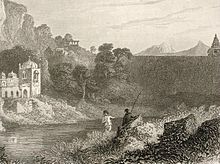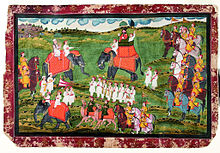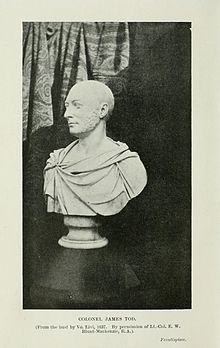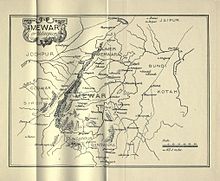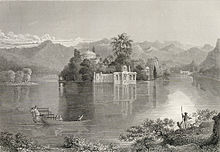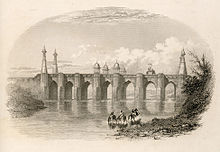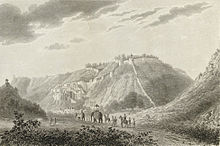- James Tod
-
For the Lower Canada seigneur and politician, see James Tod (seigneur).
 The frontispiece of the 1920 edition of Tod's Annals and antiquities of Rajasthan
The frontispiece of the 1920 edition of Tod's Annals and antiquities of Rajasthan
Lieutenant-Colonel James Tod (1782–1835) was an English officer of the British East India Company and an Oriental scholar.
Tod was born in London and educated in Scotland, later joining the East India Company as a military officer. He travelled to India in 1799 as a cadet in the Bengal Army where he rose quickly in rank. Tod eventually became captain of an escort for an envoy in a Sindian royal court. After the Third Anglo-Maratha War, during which Tod was involved in the intelligence department, he was appointed Political Agent for some areas of Rajputana. His task was to help unify the region, under the control of the East India Company. It was during this period that Tod conducted most of the research work that he would later publish. While Tod was initially successful, his methods were questioned by other members of the East India Company. Over time, his work was restricted and his areas of oversight were significantly curtailed. In 1823, due to declining health and reputation, Tod resigned his post as Political Agent and travelled back to England.
After returning to his home country Tod published a number of academic works about Indian history and geography, most notably Annals and Antiquities of Rajas'han, based on materials collected during his travels. He retired from the military in 1826, the same year in which he married Julia Clutterbuck. Tod died in 1835 aged 53.
Tod's major works have been criticised as containing significant inaccuracies and bias. However, he is highly regarded in some areas of India, particularly among those whose ancestors were praised by Tod. Furthermore, his accounts of India in general and the Rajput in specific had a significant impact on British views of the area for many years.
Contents
Life and career
Tod was born in Islington, London, on 20 March 1782.[1][nb 1] He was the second son born to his parents, James and Mary, both of whom came from families of "high standing", according to Jason Freitag.[3][nb 2] He was educated in Scotland, whence his ancestors came, although precisely where he was schooled is unknown.[5][6] Those ancestors included people who had fought with Robert the Bruce and he had a pride in this fact as well as an acute sense of what he perceived to be the chivalric values of those times.[7]
As with many people of Scots descent who sought adventure and success at that time, Tod joined the British East India Company[7] and initially spent some time studying at the Royal Military Academy, Woolwich.[8] He left England for India in 1799[nb 3] and in doing so he followed in the footsteps of various other members of his family, including his father, although Tod senior had not been in the Company but had instead owned an indigo plantation at Mirzapur.[9][nb 4] The young Tod journeyed as a cadet in the Bengal Army, appointment to which position was at the time reliant upon patronage.[10] He was appointed lieutenant in May 1800 and in 1805 was able to arrange his posting as a member of the escort to a family friend who had been appointed as Envoy and Resident to a Sindian royal court. By 1813 he had achieved promotion to the rank of captain and was commanding the escort.[11]
 Painting of Col James Tod with his Jain guru. Artist, Ghasi, Rajputana
Painting of Col James Tod with his Jain guru. Artist, Ghasi, Rajputana
The royal court was moved around the kingdom, rather than situated permanently in one place. Tod undertook various topographical and geological studies as it travelled from one area to another, using his training as an engineer and employing other people to do much of the field work. These studies culminated in 1815 with the production of a map which he presented to the Governor-General, the Marquis of Hastings. This map of "Central India" (his phrase[nb 5]) became of strategic importance to the British as they were soon to be fighting the Third Anglo-Maratha War.[11] During that war, which ran from 1817 to 1818, Tod acted as a superintendent of the intelligence department and was able to draw on other aspects of regional knowledge which he had acquired while moving around with the court. He also drew up various strategies for the military campaign.[13]
In 1818 he was appointed Political Agent for various states of western Rajputana, itself in the northwest of India, where the British East India Company had come to amicable arrangements with the Rajput rulers in order to exert indirect control over the area. The anonymous author of the introduction to Tod's posthumously published book, Travels in Western India, says that
Clothed with this ample authority, he applied himself to the arduous task of endeavouring to repair the ravages of foreign invaders who still lingered in some of the fortresses, to heal the deeper wounds inflicted by intestine [sic] feuds, and to reconstruct the framework of society in the disorganised states of Rajas'han.[14]His responsibilities were extended quickly: initially involving himself with the regions of Mewar, Kota, Sirohi and Bundi, he soon added Marwar to his portfolio and then, in 1821, was also given responsibility for Jaisalmer.[15] These areas were considered to be a strategic buffer zone against Russian advances from the north which, it was feared, might result in a move into India via the Khyber Pass. Tod believed that to achieve cohesion, and therefore assist in achieving stability in the areas and give reason for the inhabitants not to be swayed by outside forces, it was necessary that the Rajput states should contain only Rajput people, with all others being expelled. He had a "Romantic understanding of nationality", according to Ramya Sreenivasan, and "His transfers of territory between various chiefs and princes helped to create territorially consolidated states and 'routinised' political hierarchies." [16][17] His successes were plentiful and the Oxford Dictionary of National Biography notes that Tod was
... so successful in his efforts to restore peace and confidence that within less than a year some three hundred deserted towns and villages were repeopled, trade revived, and, in spite of the abolition of transit duties and the reduction of frontier customs, the state revenue had reached an amount never before known. During the next five years Tod earned the respect of both the chiefs and the people; and was able to rescue more than one princely family, including that of the ranas of Udaipur, from the destitution to which they had been reduced by Mahratta raiders.[5]Tod was not, however, universally respected in the East India Company. His immediate superior, David Ochterlony, was unsettled by Tod's rapid rise and frequent failure to consult with him. One Rajput prince objected to Tod's close involvement in the affairs of his state and succeeded in persuading the authorities to remove Marwar from Tod's area of influence. In 1821 his favouritism towards one party in a princely dispute, contrary to the orders given to him, gave rise to a severe reprimand and a formal restriction of his ability to operate without consulting Ochterlony, as well as the removal of Kota from his charge. Jaisalmer was then taken out of his sphere of influence in 1822, as official concerns grew regarding his sympathy for the Rajput princes. This and other losses of status, such as the reduction in the size of his escort, caused him to believe that his personal reputation and ability to work successfully in Mewar, by now the one area still left to him, was too diminished to be acceptable. He resigned his role as Political Agent in Mewar later that year, citing ill health.[15] He suffered from poor health for much of his life before and after that time.[18] Reginald Heber commented that
His misfortune was that, in consequence of favouring native princes so much, the government of Calcutta were led to suspect him of corruption, and consequently to narrow his powers and associate other officers with him in his trust, till he was disgusted and resigned his place. They are now satisfied, I believe, that their suspicions were groundless.[5]He left India for England in February 1823, having first travelled to Bombay by a circuitous route for his own pleasure.[19]
During the last years of his life he talked about India at functions in Paris and elsewhere across Europe. He also became a member of the newly established Royal Asiatic Society in London, for whom he acted for some time as librarian.[nb 6] He retired from his military career in 1826,[nb 7] soon after he had been promoted to Lieutenant-Colonel. His marriage to Julia Clutterbuck (daughter of Henry Clutterbuck) in 1826 produced three children but his health was declining. He spent the last year of his life abroad in an attempt to cure a chest complaint and died on 18 November 1835[5] soon after his return to England from Italy. The cause of death was an apopletic fit sustained on the day of his wedding anniversary, although he survived for a further 27 hours.[19][22] He had suffered a similar fit in 1825 as a consequence of overwork.[23]
Worldview
Theodore Koditschek has explained that Tod saw the Rajputs as "natural allies of the British in their struggles against the Mughal and Maratha states".[24] Norbert Peabody has gone further, arguing that "Maintaining the active support of groups, like the Rajputs for example, was not only important in meeting the threat of indigenous rivals but also in countering the imperial aspirations of other European powers."[25] and that some of Tod's thoughts were "implicated in [British] colonial policy toward western India for over a century."[26]
Tod's belief in the then-fashionable concept of Romantic nationalism dictated that each princely state was inhabited by only one community and this led to the expulsion of Marathas, Pindaris and other groups from Rajput territories. It also dictated redrawing the territorial boundaries of the various states in order better to delineate them as separate entities, where previously some lines – both geographical and political – had been blurred, primarily due to local arrangements based on common kinship.[nb 8] However, his successes in arranging these matters via treaties did not extend to a third pillar of his beliefs. His opinion was that British rule had supplanted Maratha rule in such a way that the Rajputs had merely swapped the onerous overlordship of one government for that of another. He was one of the architects of indirect rule, in which the princes looked after domestic affairs but paid tribute to the British for protection in foreign affairs, but he was also a critic of it. He saw the system as one that prevented achievement of true nationhood, and therefore, as Peabody describes, "utterly subversive to the stated goal of preserving them as viable entites."[28] Tod wrote in 1829 that the system of indirect rule had a tendency to "national degradation" of the Rajput territories and that this undermined them because
Who will dare to urge that a government, which cannot support its internal rule without restriction, can be national? that without power unshackled and unrestrained by exterior council or espionage, it can maintain its self-respect? This first of feelings these treaties utterly annihilate. Can we suppose such denationalised allies are to be depended upon in emergencies? or, if allowed to retain a spark of their ancient moral inheritance, that it will not be kindled into a flame against us when opportunity offers?[29]There was a political aspect to these views, most notably because he thought that if the British recast themselves as overseers seeking to re-establish lost Rajput nations then this would at once smooth the relationship between those two parties and distinguish the threatening, denationalising Marathas from the paternal, nation-creating British. It was an argument that had been deployed by others in the European arena, notably in relation to the way in which Britain portrayed the imperialism of Napoleonic France as denationalising those countries which it conquered, whereas (it was claimed) British imperialism freed people; William Bentinck noted in 1811 that "Bonaparte made kings; England makes nations".[30] However, granting sovereignty to the Rajputs was not an argument that Tod was able to win in India,[28] although the frontispiece to volume one of his Annals did contain a plea to George IV to reinstate the "former independence" of the Rajputs.[31]
While he viewed the Muslim Mughals as despotic and the Marathas as predatory,[32][nb 9] Tod saw the Rajput social systems as being similar to the feudal system of medieval Europe, and their traditions of recounting history through the generations as similar to the clan poets of the Scottish Highlanders. There was, he felt, a system of checks and balances between the ruling princes and their vassal lords, a tendency for feuds and other rivalries, and often a serf-like peasantry.[34] The Rajputs were, in his opinion, on the same developmental trajectory as nations such as Britain had followed. His ingenious use of these viewpoints enabled him later to promote in his books the notion that there was a shared experience between the people of Britain and this community in a distant, relatively unexplored area of the empire. He speculated that there was a common ancestor shared by the Rajputs and Europeans somewhere deep in pre-history and that this might be proven by comparison of the commonality in their history of ideas, such as myth and legend. In this he shared a contemporary aspiration to prove that all communities across the world had a common origin.[35][36][37] There was another appeal inherent in a feudal system and it was not unique to Tod: Metcalf has said that
In an age of industrialism and individualism, of social upheaval and laissez-faire, marked by what were perceived as the horrors of continental revolution and the rationalist excesses of Benthamism, the Middle Ages stood forth as a metaphor for paternalist ideals of social order and proper conduct ...[T]he medievalists looked to the ideals of chivalry, such as heroism, honour and generosity, to transcend the selfish calculation of pleasure and pain, and recreate a harmonious and stable society.[38]Above all, it saw character as being more worthy of admiration than wealth or intellect, and it appealed to the old landed classes at home as well as to many who worked for the Indian Civil Service.[38]
In the 1880s, Alfred Comyn Lyall revisited Tod's classification and asserted that the Rajput society was in fact tribal, based on kinship rather than feudal vassalage. He had previously generally agreed with Tod, who did accept there were claims that blood-ties played some sort of role in the relationship between princes and vassals in many states. In shifting the emphasis from a feudal to a tribal basis, Lyall was able to deny the possibility that the Rajput kingdoms might gain sovereignty. If Rajput society was not feudal then it was not on the same trajectory as European nations had followed, there was no need to consider that they might evolve into sovereign states and thus no need for Britain to consider itself to be illegitimately governing them.[34][39]
Tod's enthusiasm for bardic poetry reflected the works of Sir Walter Scott on Scottish subjects, which had a considerable influence both on British literary society and, bearing in mind Tod's Scottish ancestry, on Tod himself. Tod reconstructed Rajput history on the basis of the ancient texts and folklore of the Rajputs, although not everyone – for example, James Mill – accepted the historical validity of the native works. Tod also used philological techniques to reconstruct areas of Rajput history that were not even known to the Rajputs themselves, by drawing on works such as the Puranas.[35]
Publications
Koditschek says that Tod "developed an interest in triangulating local culture, politics and history alongside his maps",[24] and Metcalf believes of the Rajputs that Tod "ordered their past as well as their present" while working in India.[40] During his time in Rajputana, Tod was able to collect materials for his Annals and Antiquities of Rajas'han, which detailed the contemporary geography and history of Rajputana and Central India along with the history of the Rajput clans who ruled most of the area at that time. The work was published in two volumes, in 1829 and 1832,[nb 10] and included illustrations and engravings by notable artists such as the Storers, Louis Haghe and either Edward or William Finden.[44] He had to finance publication himself: sales of works on history had been moribund for some time and his name was not particularly familiar either at home or abroad.[45] Original copies are now scarce but they have been reprinted in many editions, with William Crooke's 1920 version being significantly editorialised.[46]
Freitag has argued that the Annals "is first and foremost a story of the heroes of Rajasthan ... plotted in a certain way – there are villains, glorious acts of bravery, and a chivalric code to uphold".[47] So dominant did Tod's work become in the popular and academic mind that they largely replaced the older accounts upon which Tod based much of his content, notably the Prithvirãj Rãjo and the Nainsi ri Khyãt.[48] K. S. Singh, of the Anthropological Survey of India, has explained that the Annals were primarily based on "bardic accounts and personal encounters" and that they "glorified and romanticised the Rajput rulers and their country" but ignored other communities.[49]
Tod submitted archæological papers to the Royal Asiatic Society's Transactions series and a paper on the politics of Western India that was appended to the report of the House of Commons committee on Indian affairs, 1833.[5] He had also taken notes on his journey to Bombay and collated them for another book, Travels in Western India.[19] That book was published posthumously in 1839.
In the preface to his Annals, Tod explains that,
Being desirous of epitomising the chronicles of the martial races of Central and Western India, it was essential to ascertain the sources whence they draw, or claim to draw, their lineage. For this purpose I obtained from the library of the Rana of Oodipoor Udaipur their sacred volumes, the Pooráns, and laid them before a body of pundhits, over whom presided the learned Jetty Gyanchandra. From these extracts were made of all the genealogies of the great races of Soorya and Chandra, and of facts historical and geographical.[50]An amateur numismatist, Tod is known for having discovered the first specimens of Bactrian and Indo-Greek coins from the Hellenistic period following the conquests of Alexander the Great, which were described in his books. These ancient kingdoms had been largely forgotten or considered semi-legendary but Tod's findings confirmed the long-term Greek presence in Afghanistan and Punjab. Similar coins have been found in large quantities since his death.[22][51]
Criticism
Criticism of the Annals came soon after publication. The introduction to his Travels states that
The only portions of this great work which have experienced anything like censure are those of a speculative character, namely, the curious Dissertation on the Feudal System of the Rajpoots, and the passages wherein the Author shows too visible a leaning towards hypotheses identifying persons, as well as customs, manners, and superstitions, in the East and the West, often on the slender basis of etymological affinities.[52]More severe analysis was to follow. Tod was an officer of the British imperial system, at that time the world's dominant power. Working in India he attracted the attention of local rulers who were keen to tell their own tales of defiance against the Mughal empire. He heard what they told him but knew little of what they omitted. He was a soldier writing about a caste renowned for its martial abilities, and he was aided in his writings by the very people whom he was documenting. He had been interested in Rajput history prior to coming into contact with them in an official capacity, as administrator of the region in which they lived. These factors, says Freitag, contribute to why the Annals were "manifestly biased".[53] Freitag argues that critics of Tod's literary output can be split into two groups, being those who concentrate on his errors of fact and those who concentrate on his failures of interpretation.[7]
Tod relied heavily on existing Indian texts for his historical information and most of these are today considered to be unreliable. Macaulay wrote in 1835 that "a single shelf of a good European library was worth the whole native literature of India and Arabia,"[54] while Crooke's introduction to his 1920 edition[nb 11] of the Annals, recorded that the old Indian texts recorded "the facts, not as they really occurred, but as the writer and his contemporaries supposed that they occurred."[55] That introduction continues by saying that Tod's "knowledge of ethnology was imperfect, and he was unable to reject the local chronicles of the Rajputs."[56] More recently Robin Donkin has argued that with one exception, "there are no native literary works with a developed sense of chronology, or indeed much sense of place, before the thirteenth century", and that researchers must rely on the accounts of travellers from outside the country.[57]
Examples of dubious interpretations made by Tod include his assertions regarding the ancestry of the Mohils when, even today, there is insufficient evidence to prove his point,[58] mistaking Rana Kumbha as the husband of Mira Bai,[59] and misrepresenting the story of Padmini.[60] Crooke notes in his introduction to the 1920 edition that Tod's "excursions into philology are the diversions of a clever man, not of a trained scholar, but interested in the subject as an amateur."[61] Michael Meister has commented that Tod had a "general reputation for inaccuracy ... among Indologists by late in the nineteenth century", although the opinion of those Indologists sometimes prevented them from appreciating some of the useful aspects in his work.[62] That reputation persists, with one modern writer, V. S. Srivastava, commenting that his works "... are erroneous and misleading at places and they are to be used with caution as a part of sober history".[63]
In its time Tod's work was influential, even among officials of the government, although it was never formally recognised as authoritative. Andrea Major has commented on a specific example, being the tradition of sati (ritual immolation of a widow):
The overly romanticised image of Rajasthan, and of the Rajput sati, that Tod presented came to be extremely influential in shaping British understanding of the rite's Rajput context. Though Tod does make a point of denouncing sati as a cruel and barbarous custom, his words are belied by his treatment of the subject in the rest of the Annals. ... Tod's image of the Rajput sati as the heroic equivalent of the Rajput warrior was one that caught the public imagination and which exhibited surprising longevity.[64]The romantic nationalism that Tod espoused was used by Indian nationalist writers certainly from the 1850s as they sought to resist British control of the country. Works such as Jyotirindranath Tagore's Sarojini ba Chittor Akrama and Girishchandra Ghosh's Ananda Raho retold Tod's vision of the Rajputs in a manner to further their cause.[31] In India today, he is still revered by those whose ancestors he documented in good light. In 1997 the Maharana Mewar Charitable Foundation instituted an award named after Tod and intended to be given to modern non-Indian writers who exemplified Tod's understanding of the area and its people.[65] In other recognition of his work in Mewar Province, a village has been named Todgarh,[66] and it has been claimed that Tod was in fact a Rajput as an outcome of the process of karma and rebirth.[67] Freitag describes the opinion of the Rajput people
Tod, here, is not about history as such, but is a repository for "truth" and "splendor" ... The danger, therefore, is that the old received wisdom – evident and expressed in the work of people like Tod – will not be challenged at all, but will become much more deeply ingrained.[53]Furthermore, Freitag points out that "The information age has also anointed Tod as the spokesman for Rajasthan, and the glories of India in general, as attested by the prominent quotations from him that appear in tourism related websites."[68]
See also
References
- Notes
- ^ Although 20 March 1782 is generally used as his date of birth, documentation for his christening states it as 19 March.[2]
- ^ As of 2009, when his biography of Tod was published, Jason Freitag was not aware of any other book-length study of Tod. Freitag received hospitality from His Highness Arvind Singh Mewar, of the Mewar royal family, during the process that resulted in publication of his work. Much of the content of Freitag's book appears in his earlier PhD thesis.[4]
- ^ Freitag says Tod left for India in 1798 in his 2007 work, and in 1799 in his 2009 work.
- ^ Suetonius Grant Heatly was another of Tod's relatives who spent time in India. He was an uncle and, together with one or perhaps two other colleagues from the East India Company, he is the first documented instance of someone attempting the commercial extraction of coal in the country. Suetonius Heatly died before James Tod entered the service of the Company; another uncle – Suetonius's brother, Patrick Heatly – did not die until 1834 and also worked for the Company both in India and in London.
- ^ It is possible that Tod also coined the term Rajasthan.[12]
- ^ Fellowships of the Royal Asiatic Society appear not to have existed at the time of his death in 1835, but at that point he was a member of the Society's Oriental Translation Committee.[20]
- ^ The introduction to Tod's Travels in Western India gives the date of his retirement from military service as 28 June 1825 but recent sources use 1826.[21]
- ^ Romantic nationalism found much support as an alternative theory to civic nationalism and was a force behind the nineteenth century unifications of Germany and Italy.[27]
- ^ It had been a commonly held view since at least the time of the Crusades that Muslim rulers were despotic because it was thought that Islamic belief system promoted such tendencies; in the words of Alexander Dow it was "peculiarly calculated for despotism".[33]
- ^ The Annals were sold at a price of £4. 14s. 6d. per volume,[41][42] and the Travels sold for £3. 13s. 6d.[43]
- ^ The 1920 edition of the Annals was produced in three volumes rather than the original two volumes.
- Citations
- ^ Vaishishtha, p. 152.
- ^ Freitag (2009), p. 33.
- ^ Freitag (2001), p. 29.
- ^ Freitag (2009), p. 9, n. 4 p. 33.
- ^ a b c d e Wheeler (Oxford Dictionary of National Biography)
- ^ Freitag (2009), p. 35.
- ^ a b c Freitag (2007), p. 49.
- ^ Tod (1839), p. xviii.
- ^ Freitag (2001), p. 30.
- ^ Freitag (2001), p. 31.
- ^ a b Freitag (2009), pp. 34–36.
- ^ Freitag (2009), n. 17 p. 36.
- ^ Freitag (2009), p. 37.
- ^ Tod (1839), p. xxxiii.
- ^ a b Freitag (2009), pp. 37–40.
- ^ Sreenivasan, pp. 126–127.
- ^ Peabody, p. 203.
- ^ Freitag (2009), p. 41.
- ^ a b c Freitag (2009), p. 40.
- ^ Royal Asiatic Society (1835), Appendix, pp. xlvii–liv, lxi.
- ^ Tod (1839), p. l.
- ^ a b The Gentleman's Magazine, February 1836, pp. 203–204.
- ^ Tod (1839), p. xlvii.
- ^ a b Koditchek, p. 68.
- ^ Peabody, p. 204.
- ^ Peabody, p. 185.
- ^ Hutchinson (2005), pp. 49–50.
- ^ a b Peabody, pp. 206–207.
- ^ Tod (1829), Vol. 1., pp. 125–6.
- ^ Peabody, p. 209.
- ^ a b Peabody, p. 217.
- ^ Peabody, p. 212.
- ^ Metcalf (1997), p. 8.
- ^ a b Metcalf (1997), pp. 73–74.
- ^ a b Sreenivasan, pp. 130–132.
- ^ Koditchek, p. 69.
- ^ Tod (1829), Vol. 1., pp. 72–74.
- ^ a b Metcalf (1997), p. 75.
- ^ Peabody, p. 215.
- ^ Metcalf (1997), p. 73.
- ^ Edinburgh Review, p. 13.
- ^ Asiatic Journal (1832), p. 80.
- ^ British Magazine, p. 359.
- ^ London Literary Gazette, p. 536.
- ^ Tod (1839), pp. li–lii.
- ^ Peabody, p. 187.
- ^ Freitag (2001), p. 20.
- ^ Freitag (2009), p. 10.
- ^ Singh, p. xvi.
- ^ Tod (1829), Vol. 1., p. 17.
- ^ Wilson, pp. 4–10.
- ^ Tod (1839), pp. lii–liii.
- ^ a b Freitag (2009), pp. 3–5.
- ^ Macaulay
- ^ Crooke (Annals, 1920 ed.), introduction to Vol. 1., p. xxx.
- ^ Crooke (Annals, 1920 ed.), introduction to Vol. 1., p. xxxi.
- ^ Donkin, p. 152.
- ^ Handa, p. RA-120.
- ^ Nilsson, pp. 12, 19.
- ^ Sreenivasan, p. 140.
- ^ Crooke (Annals, 1920 ed.), introduction to Vol. 1., p. xxxix.
- ^ Meister, pp. 56–73.
- ^ Srivastava, p. 120.
- ^ Major, p. 33.
- ^ Freitag (2009), pp. 2, 4.
- ^ Sebastian
- ^ Freitag (2009), n. 2 p. 2.
- ^ Freitag (2009), pp. 8–9.
- Bibliography
- Donkin, Robin A. (1998). "Beyond price: pearls and pearl-fishing: origins to the age of discoveries". Memoirs of the American Philosophical Society (Philadelphia: American Philosophical Society) 224. ISBN 0-87169-224-5. http://books.google.com/books?id=leHFqMQ9mw8C. Retrieved 2011-07-28.
- Freitag, Jason (2007). "Travel, history, Politics, Heritage: James Tod's "Personal Narrative"". In Henderson, Carol E.; Weisgrau, Maxine K.. Raj rhapsodies: tourism, heritage and the seduction of history. Aldershot: Ashgate Publishing. ISBN 978-0-7546-7067-4. http://books.google.com/books?id=6ozNAdqKfHwC. Retrieved 2011-08-08.
- Freitag, Jason (2001). The power which raised them from ruin and oppression: James Tod, historiography, and the Rājpūt ideal. http://en.scientificcommons.org/48395863. Retrieved 2011-10-05.(subscription required)
- Freitag, Jason (2009). Serving empire, serving nation: James Tod and the Rajputs of Rajasthan. Leiden: BRILL. ISBN 978-90-04-17594-5. http://books.google.com/books?id=Ib93BhAu43gC. Retrieved 2011-07-27.
- Handa, Devendra (1981). "An interesting inscribed relief dated S. 1010 from Ladmun". In Prakash, Satya; Śrivastava, Vijai Shankar. Cultural contours of India: Dr. Satya Prakash felicitation volume. New Delhi: Abhinav Publications. ISBN 978-0-391-02358-1. http://books.google.com/books?hl=en&lr=&id=nKJiBUFrmfoC&oi=fnd&pg=RA1-PA120. Retrieved 2011-07-09.
- Hutchinson, John (2005). Nations as zones of conflict. London: SAGE. ISBN 978-0-7619-5727-0. http://books.google.com/books?id=huLYBcqURwQC. Retrieved 2011-08-11.
- Koditschek, Theodore (2011). Liberalism, Imperialism, and the Historical Imagination: Nineteenth Century Visions of a Greater Britain. Cambridge: Cambridge University Press. ISBN 978-0-521-76791-0. http://books.google.com/books?id=heOq2CIzEtAC. Retrieved 2011-07-28.
- Macaulay, Thomas Babington (1835). Minute on Indian Education. Santa Barbara: Rita Raley, Dept of English, University of California, Santa Barbara. http://www.english.ucsb.edu/faculty/rraley/research/english/macaulay.html. Retrieved 2011-07-28.
- Major, Andrea (2010). Sovereignty and social reform in India: British colonialism and the campaign against Sati, 1830–1860. Abingdon: Routledge (Taylor & Francis e-Library). ISBN 978-0-415-58050-2. http://books.google.com/books?id=RQ2-9-11TIUC. Retrieved 2011-07-29.
- Meister, Michael W. (1981). "Forest and Cave: Temples at Candrabhāgā and Kansuāñ". Archives of Asian Art (University of Hawai'i Press for the Asia Society) 34. ISSN 1944-6497. JSTOR 20111117.(subscription required)
- Metcalf, Thomas R. (1997). Ideologies of the Raj. The New Cambridge History of India, Volume 4 (Reprinted ed.). Cambridge: Cambridge University Press. ISBN 978-0-521-58937-6. http://books.google.com/books?id=TRcMoGSkRtIC. Retrieved 2011-08-10.
- Nilsson, Usha (1997). Mira Bai. New Delhi: Sahitya Akademi. ISBN 978-81-260-0411-9. http://books.google.com/books?hl=en&lr=&id=ZvUvAFCQWPoC&oi. Retrieved 2011-07-09.
- Peabody, Norbert (1996). "Tod's Rajast'han and the Boundaries of Imperial Rule in Nineteenth-Century India". Modem Asian Studies (Cambridge: Cambridge University Press) 30 (1): 185–220. ISSN 0026-749X. http://journals.cambridge.org/action/displayAbstract?fromPage=online&aid=2686800.(subscription required)
- Sebastian, Sunny (4 October 2010). "Rajasthan now plans an eco-train safari". The Hindu (Jaipur). http://www.thehindu.com/todays-paper/tp-national/tp-newdelhi/article812142.ece. Retrieved 2011-07-27.
- Sreenivasan, Ramya (2007). The many lives of a Rajput queen: heroic pasts in India c. 1500–1900. Seattle: University of Washington Press. ISBN 978-0-295-98760-6. http://books.google.com/books?id=GiSUwULkK64C. Retrieved 2011-07-29.
- Srivastava, Vijai Shankar (1981). "The story of archaelogical, historical and antiquarian researches in Rajasthan before independence". In Prakash, Satya; Śrivastava, Vijai Shankar. Cultural contours of India: Dr. Satya Prakash felicitation volume. New Delhi: Abhinav Publications. ISBN 978-0-391-02358-1. http://books.google.com/books?id=nKJiBUFrmfoC&pg=PA31. Retrieved 2011-07-09.
- Singh, Kumar Suresh (1998). People of India: Rajasthan, Part 1. Volume 38 of People of India. Mumbai: Popular Prakashan. ISBN 978-81-7154-766-1. http://books.google.com/books?id=nqvloPNdEZgC. Retrieved 2011-07-28.
- Tod, James (1920) [1829]. Crooke, William. ed. Annals and Antiquities of Rajast'han or the Central and Western Rajpoot States of India, Volume 1. London: Humphrey Milford / Oxford University Press. http://www.archive.org/details/annalsantiquitie01todj. Retrieved 2011-07-27.
- Tod, James (1839). Travels in Western India. London: W. H. Allen. http://catalog.hathitrust.org/Record/001867080.
- Vaishishtha, Vijay Kumar (1992). "James Tod as a Historian". In Sharma, Gopi Nath; Bhatnagar, V. S.. The Historians and sources of history of Rajasthan. Centre for Rajasthan Studies, University of Rajasthan. http://books.google.com/books?id=LgscAAAAIAAJ. Retrieved 2011-07-27.
- "Tod, James", on the website of the Oxford Dictionary of National Biography (Subscription or UK public library membership required), http://dx.doi.org/10.1093/ref:odnb/27486
- Wilson, Horace Hayman (1998) [1841]. Ariana antiqua: a descriptive account of the antiquities and coins of Afghanistan (Reprinted ed.). New Delhi: Asian Educational Services. ISBN 978-81-206-1189-4. http://books.google.com/books?id=s_K_gcxHz5YC. Retrieved 2011-07-27.
- East India Company (May–August 1832). "New publications". Asiatic Journal and monthly miscellany. New Series (London: Wm. H. Allen & Co.) 8 (29). http://books.google.com/books?id=NxYLAQAAMAAJ. Retrieved 2011-07-28.
- "New Books". The British Magazine (London: J. Petheram) XVI. 1 September 1839. http://books.google.com/books?id=xoVPAAAAMAAJ. Retrieved 2011-07-28.
- "Advertisement". The Edinburgh Review CI. April 1830. http://books.google.com/books?id=zSlIPPTTKFEC. Retrieved 2011-07-28.
- "Sights of books". The Literary Gazette and Journal (London: The Literary Gazette) (656). 15 August 1829. http://books.google.com/books?id=K_ekQOZf1yMC. Retrieved 2011-07-28.
- "Obituary". The Gentleman's Magazine. New Series (London: William Pickering; John Bowyer Nichols and Son) 5. February 1836. http://books.google.com/books?id=u1NIAAAAYAAJ&pg=PA203. Retrieved 2011-07-27.
- "Appendix: Rules and Regulations of the Society; Members of the Oriental Translation Committee". Journal of the Royal Asiatic Society of Great Britain and Ireland (London: John W. Parker) 2. 1835. http://www.archive.org/details/journalroyalasi41irelgoog. Retrieved 2011-10-23.
Further reading
- By Tod
- Tod, James (1824). "Translation of a Sanscrit Inscription, Relative to the Last Hindu King of Delhi, with Comments Thereon". Transactions of the Royal Asiatic Society of Great Britain and Ireland (London) 1 (1): 133–154. http://www.archive.org/details/transactionsofro01asia.
- Tod, James (1826). "Comments on an Inscription upon Marble, at Madhucarghar; And Three Grants Inscribed on Copper, Found at Ujjayani". Transactions of the Royal Asiatic Society of Great Britain and Ireland (London) 1 (2): 207–229. http://www.archive.org/details/transactionsofro01asia.
- Tod, James (1826). "An Account of Greek, Parthian, and Hindu Medals, Found in India". Transactions of the Royal Asiatic Society of Great Britain and Ireland (London) 1 (2): 313–342. http://www.archive.org/stream/transactionsofro01asia#page/n377/mode/2up/search/tod.
- Tod, James (1829). "On the Religious Establishments of Mewar". Transactions of the Royal Asiatic Society of Great Britain and Ireland (London) 2 (1): 270–325. http://www.archive.org/stream/transactionsofro02asia#page/270/mode/2up.
- Tod, James (1829). "Remarks on Certain Sculptures in the Cave Temples of Ellora". Transactions of the Royal Asiatic Society of Great Britain and Ireland (London) 2 (1): 328–339. http://www.archive.org/stream/transactionsofro02asia#page/328/mode/2up/search/tod.
- Tod, James (1829). Annals and Antiquities of Rajast'han or the Central and Western Rajpoot States of India, Volume 1. London: Smith, Elder.
- Tod, James (1830). "Observations on a Gold Ring of Hindu Fabrication found at Montrose in Scotland". Transactions of the Royal Asiatic Society of Great Britain and Ireland (London) 2 (2): 559–571. http://www.archive.org/details/transactionsofro02asia.
- Tod, James (1831). "Comparison of the Hindu and Theban Hercules, illustrated by an ancient Hindu Intaglio". Transactions of the Royal Asiatic Society of Great Britain and Ireland (London) 3 (1): 139–159. http://www.archive.org/details/transactionsofro03asia.
- Tod, James (1832). Annals and Antiquities of Rajast'han or the Central and Western Rajpoot States of India, Volume 2. London: Smith, Elder. http://www.archive.org/details/annalsandantiqu00todgoog.
- Tod, James (1839). Travels in Western India. London: W. H. Allen. http://catalog.hathitrust.org/Record/001867080.
- By others
- Freitag, Jason (2001). The power which raised them from ruin and oppression: James Tod, historiography, and the Rājpūt ideal (PhD thesis). http://en.scientificcommons.org/48395863. Retrieved 2011-08-01.(subscription required)
- Ojha, Gaurishankar Hirachand (2002). Suprasiddha itihaskara Karnala James Toda ka jivana charitra (in Hindi). Jodhpur: Rajasthani Granthagara.
- Tillotson, Giles (2008). James Tod's Rajasthan: The Historian and His Collections. Mumbai: Radhika Sabavala for Marg Publications on behalf of the National Centre for the Performing Arts. ISBN 81-85026-80-7. http://books.google.com/books?id=U6DpAAAAMAAJ.
- East India Company (August 1829). "Review of books: Annals and Antiquities of Rajast'han". Asiatic Journal and monthly miscellany (London: Wm. H. Allen & Co.) 28 (164): 187–198. http://books.google.com/books?id=MrZAAQAAIAAJ&pg=PA187.
- East India Company (May–August 1832). "Colonel Tod's History of Rajpootana (book review, volume 2)". Asiatic Journal and monthly miscellany. New Series (London: Wm. H. Allen & Co.) 8 (29): 57–66. http://books.google.com/books?id=NxYLAQAAMAAJ&pg=PA57.
- "Reviews". The Athenaeum (London) (613): 555–558. 27 July 1839. http://books.google.com/books?id=abNHAQAAIAAJ&pg=PA555. – A partial review of Travels, concluded in the subsequent issue.
- "Treaty with the Rajah of Boondee". Treaties and engagements with native princes and states in India 1817 and 1818. 1824. p. xci. http://books.google.com/books?id=sklDAAAAcAAJ&pg=PR91. – an example of a treaty in which Tod was involved.
External links
- "Colonel James Tod Award". Eternal Mewar. http://www.eternalmewar.in/User/governance/Award/ColonelJamesTodAward.aspx. Retrieved 2011-07-28.
Categories:- 1782 births
- 1835 deaths
- British historians
- History of Rajasthan
- British numismatists
- British cartographers
- English people of Scottish descent
- People from Islington (district)
- British East India Company Army officers
- Historians of India
Wikimedia Foundation. 2010.

